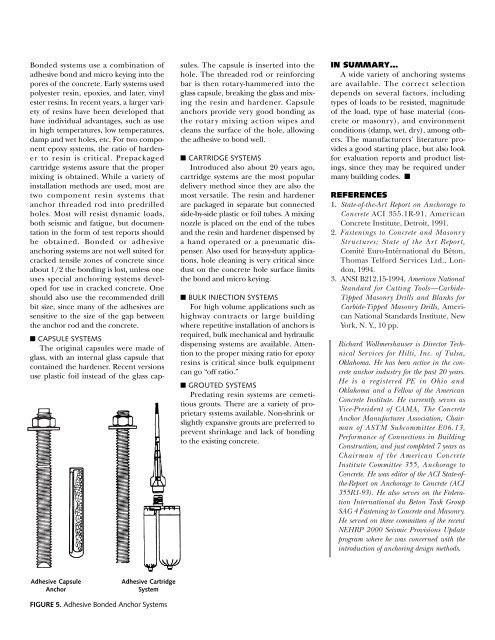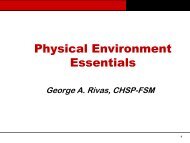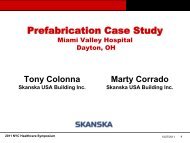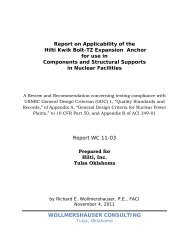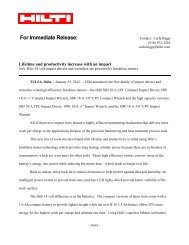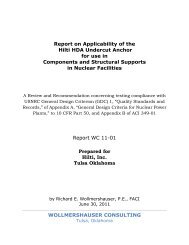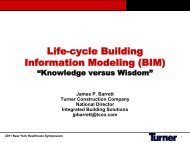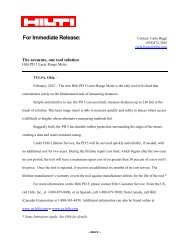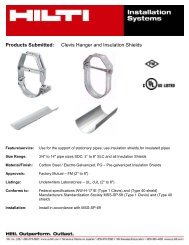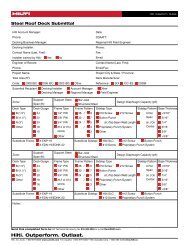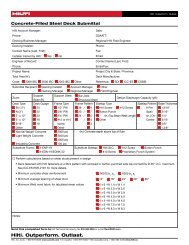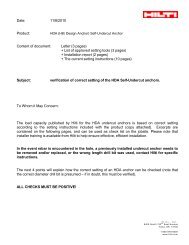Types of Anchors for Anchoring to Concrete - Hilti
Types of Anchors for Anchoring to Concrete - Hilti
Types of Anchors for Anchoring to Concrete - Hilti
Create successful ePaper yourself
Turn your PDF publications into a flip-book with our unique Google optimized e-Paper software.
Bonded systems use a combination <strong>of</strong><br />
adhesive bond and micro keying in<strong>to</strong> the<br />
pores <strong>of</strong> the concrete. Early systems used<br />
polyester resin, epoxies, and later, vinyl<br />
ester resins. In recent years, a larger variety<br />
<strong>of</strong> resins have been developed that<br />
have individual advantages, such as use<br />
in high temperatures, low temperatures,<br />
damp and wet holes, etc. For two component<br />
epoxy systems, the ratio <strong>of</strong> hardener<br />
<strong>to</strong> resin is critical. Prepackaged<br />
cartridge systems assure that the proper<br />
mixing is obtained. While a variety <strong>of</strong><br />
installation methods are used, most are<br />
two component resin systems that<br />
anchor threaded rod in<strong>to</strong> predrilled<br />
holes. Most will resist dynamic loads,<br />
both seismic and fatigue, but documentation<br />
in the <strong>for</strong>m <strong>of</strong> test reports should<br />
be obtained. Bonded or adhesive<br />
anchoring systems are not well suited <strong>for</strong><br />
cracked tensile zones <strong>of</strong> concrete since<br />
about 1/2 the bonding is lost, unless one<br />
uses special anchoring systems developed<br />
<strong>for</strong> use in cracked concrete. One<br />
should also use the recommended drill<br />
bit size, since many <strong>of</strong> the adhesives are<br />
sensitive <strong>to</strong> the size <strong>of</strong> the gap between<br />
the anchor rod and the concrete.<br />
■ CAPSULE SYSTEMS<br />
The original capsules were made <strong>of</strong><br />
glass, with an internal glass capsule that<br />
contained the hardener. Recent versions<br />
use plastic foil instead <strong>of</strong> the glass capsules.<br />
The capsule is inserted in<strong>to</strong> the<br />
hole. The threaded rod or rein<strong>for</strong>cing<br />
bar is then rotary-hammered in<strong>to</strong> the<br />
glass capsule, breaking the glass and mixing<br />
the resin and hardener. Capsule<br />
anchors provide very good bonding as<br />
the rotary mixing action wipes and<br />
cleans the surface <strong>of</strong> the hole, allowing<br />
the adhesive <strong>to</strong> bond well.<br />
■ CARTRIDGE SYSTEMS<br />
Introduced also about 20 years ago,<br />
cartridge systems are the most popular<br />
delivery method since they are also the<br />
most versatile. The resin and hardener<br />
are packaged in separate but connected<br />
side-by-side plastic or foil tubes. A mixing<br />
nozzle is placed on the end <strong>of</strong> the tubes<br />
and the resin and hardener dispensed by<br />
a hand operated or a pneumatic dispenser.<br />
Also used <strong>for</strong> heavy-duty applications,<br />
hole cleaning is very critical since<br />
dust on the concrete hole surface limits<br />
the bond and micro keying.<br />
■ BULK INJECTION SYSTEMS<br />
For high volume applications such as<br />
highway contracts or large building<br />
where repetitive installation <strong>of</strong> anchors is<br />
required, bulk mechanical and hydraulic<br />
dispensing systems are available. Attention<br />
<strong>to</strong> the proper mixing ratio <strong>for</strong> epoxy<br />
resins is critical since bulk equipment<br />
can go “<strong>of</strong>f ratio.”<br />
■ GROUTED SYSTEMS<br />
Predating resin systems are cemetitious<br />
grouts. There are a variety <strong>of</strong> proprietary<br />
systems available. Non-shrink or<br />
slightly expansive grouts are preferred <strong>to</strong><br />
prevent shrinkage and lack <strong>of</strong> bonding<br />
<strong>to</strong> the existing concrete.<br />
IN SUMMARY…<br />
A wide variety <strong>of</strong> anchoring systems<br />
are available. The correct selection<br />
depends on several fac<strong>to</strong>rs, including<br />
types <strong>of</strong> loads <strong>to</strong> be resisted, magnitude<br />
<strong>of</strong> the load, type <strong>of</strong> base material (concrete<br />
or masonry), and environment<br />
conditions (damp, wet, dry), among others.<br />
The manufacturers’ literature provides<br />
a good starting place, but also look<br />
<strong>for</strong> evaluation reports and product listings,<br />
since they may be required under<br />
many building codes. ■<br />
REFERENCES<br />
1. State-<strong>of</strong>-the-Art Report on Anchorage <strong>to</strong><br />
<strong>Concrete</strong> ACI 355.1R-91, American<br />
<strong>Concrete</strong> Institute, Detroit, 1991.<br />
2. Fastenings <strong>to</strong> <strong>Concrete</strong> and Masonry<br />
Structures; State <strong>of</strong> the Art Report,<br />
Comité Euro-Intérnational du Bé<strong>to</strong>n,<br />
Thomas Tel<strong>for</strong>d Services Ltd., London,<br />
1994.<br />
3. ANSI B212.15-1994, American National<br />
Standard <strong>for</strong> Cutting Tools—Carbide-<br />
Tipped Masonry Drills and Blanks <strong>for</strong><br />
Carbide-Tipped Masonry Drills, American<br />
National Standards Institute, New<br />
York, N. Y., 10 pp.<br />
Richard Wollmershauser is Direc<strong>to</strong>r Technical<br />
Services <strong>for</strong> <strong>Hilti</strong>, Inc. <strong>of</strong> Tulsa,<br />
Oklahoma. He has been active in the concrete<br />
anchor industry <strong>for</strong> the past 20 years.<br />
He is a registered PE in Ohio and<br />
Oklahoma and a Fellow <strong>of</strong> the American<br />
<strong>Concrete</strong> Institute. He currently serves as<br />
Vice-President <strong>of</strong> CAMA, The <strong>Concrete</strong><br />
Anchor Manufactures Association, Chairman<br />
<strong>of</strong> ASTM Subcommittee E06.13,<br />
Per<strong>for</strong>mance <strong>of</strong> Connections in Building<br />
Construction, and just completed 7 years as<br />
Chairman <strong>of</strong> the American <strong>Concrete</strong><br />
Institute Committee 355, Anchorage <strong>to</strong><br />
<strong>Concrete</strong>. He was edi<strong>to</strong>r <strong>of</strong> the ACI State-<strong>of</strong>the-Report<br />
on Anchorage <strong>to</strong> <strong>Concrete</strong> (ACI<br />
355R1-93). He also serves on the Federation<br />
International du Be<strong>to</strong>n Task Group<br />
SAG 4 Fastening <strong>to</strong> <strong>Concrete</strong> and Masonry.<br />
He served on three committees <strong>of</strong> the recent<br />
NEHRP 2000 Seismic Provisions Update<br />
program where he was concerned with the<br />
introduction <strong>of</strong> anchoring design methods.<br />
Adhesive Capsule<br />
Anchor<br />
Adhesive Cartridge<br />
System<br />
FIGURE 5. Adhesive Bonded Anchor Systems


